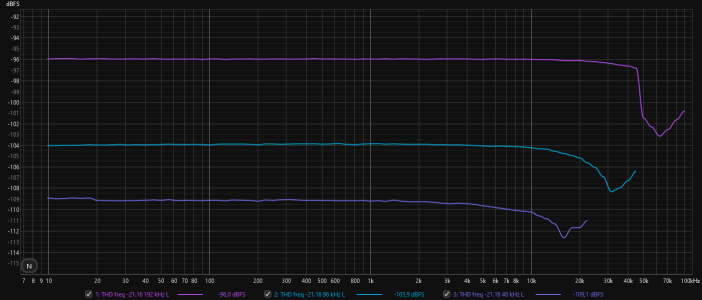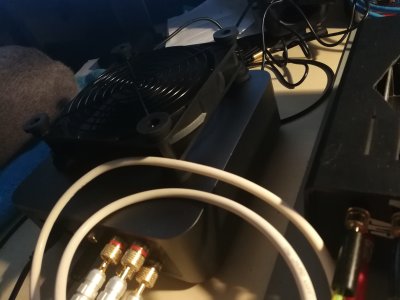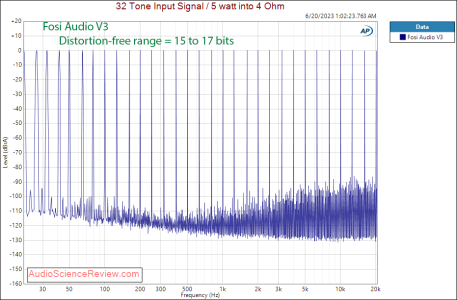Well, not finished. Yet. But let's start with some facts.
The Amp seems to be a class D BTL H-bridge amp with a single power rail (find someone smarter than me for an explanation), and with an advanced temperature monitoring through some sensors to deliver "optimal performance and safety" which results in the output power optimizations. It has some consequences for measurements.
First of all, the output signal is modulated by high frequency switching signal, 454.5 kHz in this case:

As it shouldn't bother typical speakers, it affects any measurement instruments. Especially noise level increases when BW of the ADC is wide enough.
I will start my measurements with a bare ADC and then I will compare results with the ones when a low pass filter is used to attenuate the switching signal (I hope I will succeed with the build of an LPF).
Second thing is a DC bias on speaker outputs in relation to the amp ground. It's 20V DC which means that the amp is powered internally from 40V DC. That also means that I could burn my ADC AC coupling capacitors as the DC voltage level is too high, when common ground between the amp and ADC is established. I will start my tests with my ADC floating to protect it from the DC bias. I will verify later if using an external AC coupling capacitors brings more reliable measurement results.
And a third thing, those output power optimizations make measurements slightly challenging in case of high output powers as the output voltage may vary and even fluctuate. I've been told that a FW update is incoming with some power related improvements. So far I had to focus on 1W output power results.
Few other facts:
- the Amp can consume as much as 323W AC power for full scale sine signal in stereo at the highest volume and with 4 ohm load. In case of 8 ohm it's reduced to 163W.
- typical consumption is between 11W and 14W when nothing is played, it goes down to 6W for an "idle" mode and can drop to below 1W under some circumstances, in such case the Amp looses its WiFi connection and cannot be awaken with the remote
- max output power is 124W per channel for both channels loaded and 4 ohm load, and 63W for 8 ohm
- USB output can deliver up to 660mA at stable 4.72V voltage
- amplifier gain is around 27 dB
Just one graph for today - some class D amplifiers are known to have a frequency response influenced by load impedance. The same behavior can be seen with the Amp, plot below was made for 1W output power and a sweep with 48 kHz signal:

In real life scenarios it can sound "bright" or "dull", but it will depend on the speaker and its impedance for increasing frequencies.
Just one preliminary result I got for 5W/4ohm sine 1k signal, so quite comparable to measurements usually seen on ASR website:
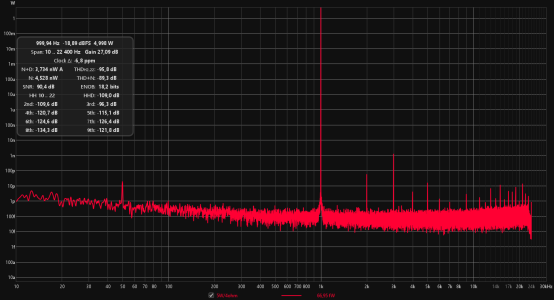
Unfortunately both noise related measurements - THD+N and SNR - are lower than expected, even with very limited BW. It can indicate that I will need an LPF for better results.
THD: 95.8 dB
THD+N: 89.3 dB
SNR: 90.4 dB
Above is for single channel only.
A word about some concerns I have so far.
My unit is humming, buzzing, or hissing, no idea which word fits the best but the amp produces some noise from itself. It's more quiet with mediocre volume levels but gets louder for high power outputs. And unfortunately also when in idle. I can imagine it won't bother in daily use, but when it sits on the desk it's simply annoying. Fortunately I've been told that the noise is from the power transformer and it won't happen to production units.
Another thing is that the device outputs high frequency component on the sub out. It's at 520 kHz and -15 dBV level which gives the overall Vpp of 680 mV even when no content is played. It's beyond my expertise level to say if it's safe or not for the connected subwoofer but as it affects the performance of my ADC I can imagine it can have some impact on active subwoofers if HF signal is not filtered out. I've been told that the root cause has been identified and it's the power supply.
There are no DAC selectable filters (yet?), the default one seems to be fast, linear phase one, with responses as below

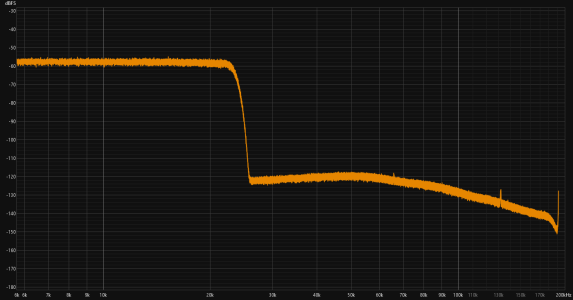
Undithered -90.31dBFS 16 bit sine signal doesn't look very good, but remains undithered

Measurements - optical in to speakers out
EDIT: since I now have LPF, all content has been revised and corrected where necessary
All measurements here are taken with Cosmos ADC and REW. My dummy load is purely resistive, 4 or 8 ohms. Both channels are always driven. Low pass filter against class D switching frequency was used. Amp's volume is set to 100%.
Using the LPF does not bring a significant improvement. Although its filtering capability is impressive
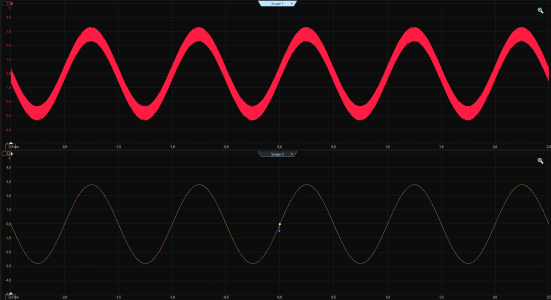

it does not translate into measurement results. The biggest observed differences were related to the noise level for higher sample rates

Linearity is quite good, with 0.5 dB deviation at 110 - 111 dBFS source level (111 - 112 with LPF)

SINAD measured for 5W/4ohm 48 kHz sine signal was 88.7 - 89.1 dB. SNR 90.6 dB. SNR jumps to 103 dB for full power signal.
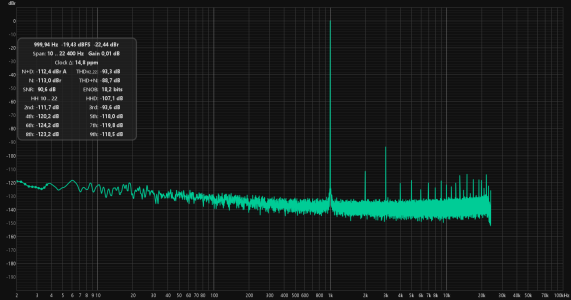
Dynamic range calculated with -60 dBFS sine signal reaches 105 dB, while noise stays at 124 uV.
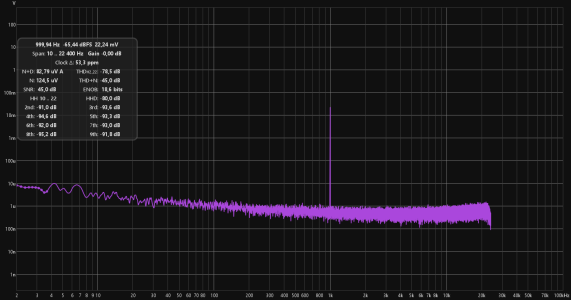
IMD distortions measured using SMPTE signal keep low level for 1W signal, but rise significantly at 5W (well, in fact I shouldn't call it IMD, these ones are just harmonics of 60 Hz tone)
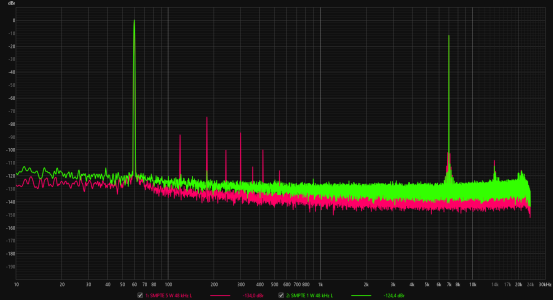
It affects badly multitone results which are simply terrible for higher output levels, below 1W vs 5W again
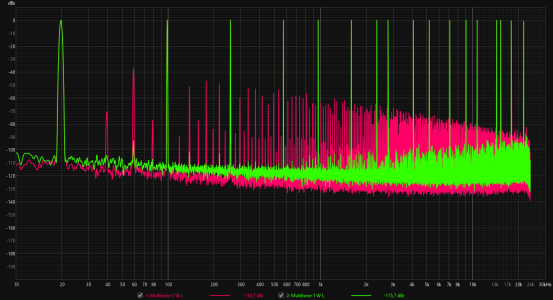
I've enabled a subwoofer output to verify if it influences results, but no, still horrible
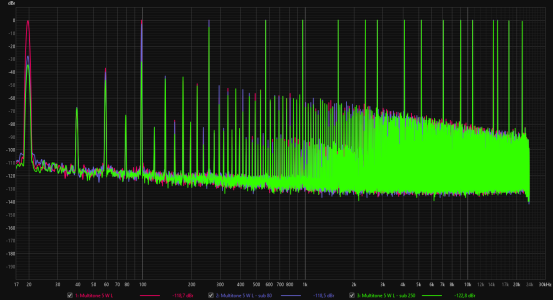
The frequency response shows a dependency to the load, as mentioned already. As a result the response within +/- 0.5 dB deviation covers an audible range fully for 4 ohm, but reaches 14 kHz only for 8 ohm load.

THD vs power shows similar performance for 1kHz sine signal and 4 vs 8 ohm load
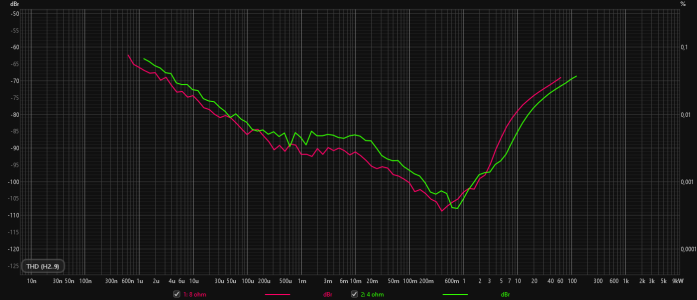
THD+N vs power plots for different frequencies show increased distortions at lower frequencies
4 ohm
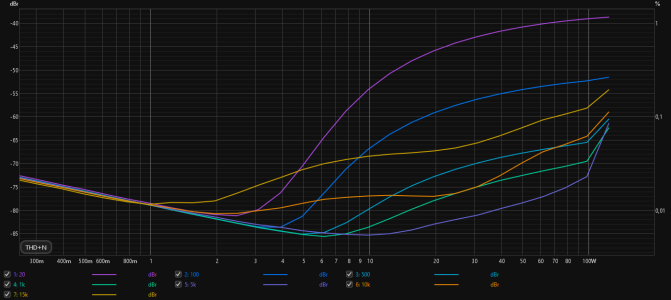
8 ohm
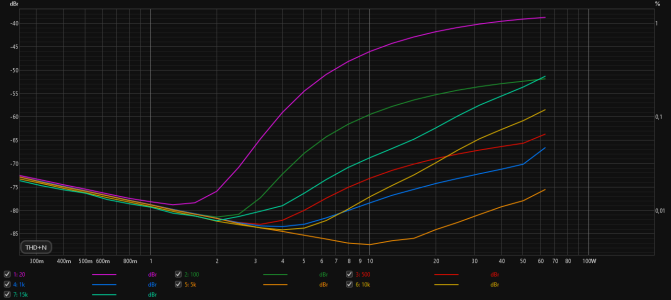
Best results at high powers are achieved around 5 kHz, it's also visible on THD vs frequency plot, below for 8 ohm, 5W

Harmonic distortions are dominated by uneven ones, below for 1 kHz sine at 4 ohm
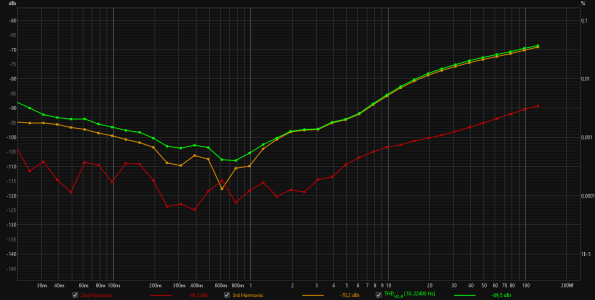
SMPTE vs power and multitone vs power both show similar total distortion curves, as affected mainly by low frequency issues, 4 ohm
SMPTE
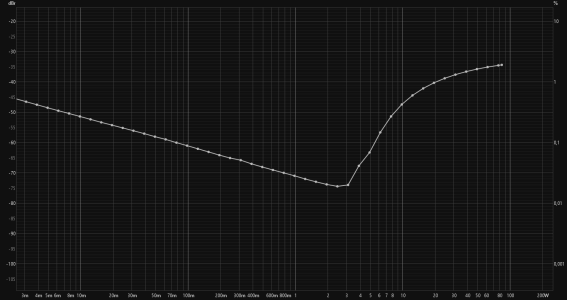
Multitone
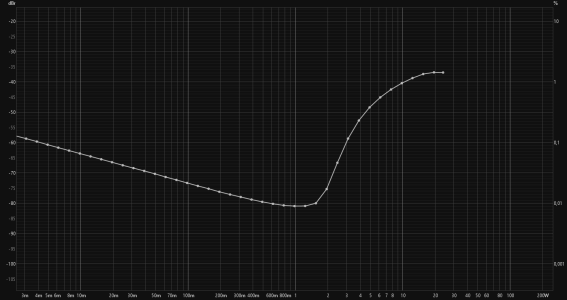
While right channel shows slightly better performance for low frequencies
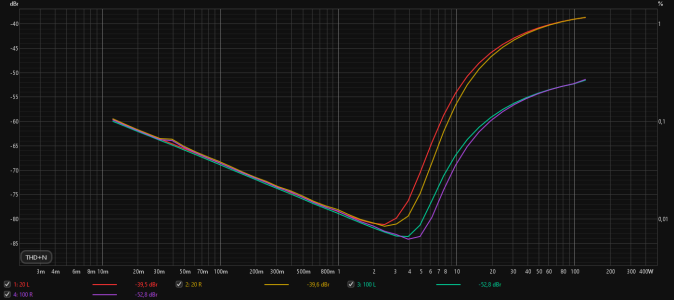
it's opposite for high frequencies
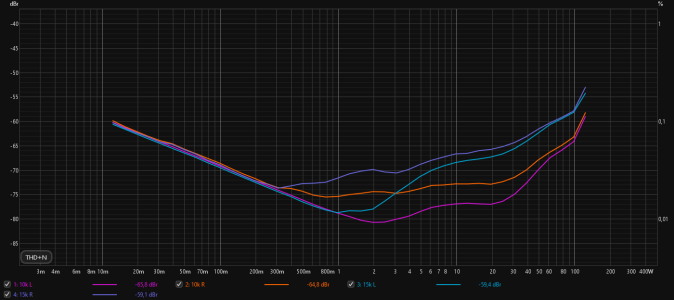
My conclusion for this part is that the performance for low frequencies is, again (Pro Plus V1?), disappointing. While the Amp measurements are similar to the ones seen for other 3255 implementations, low frequencies are broken. It's unclear to me if it's an issue of my particular unit or it's a design flaw, as other measurements are not yet available publicly.
Output impedance is as below (using 4 ohm load for measurements)
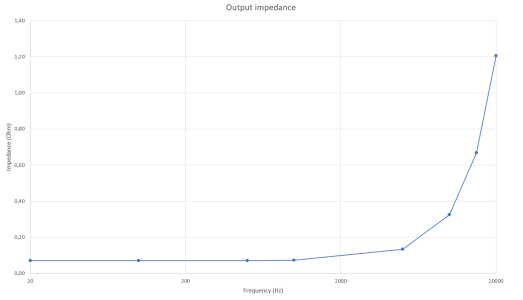
Measurements - optical in to sub out
For this purpose I use 200 Hz crossover frequency and 100 Hz test sine signal.
Just like for speakers output, the subwoofer output is also affected by the HF switching signal at around 521 kHz
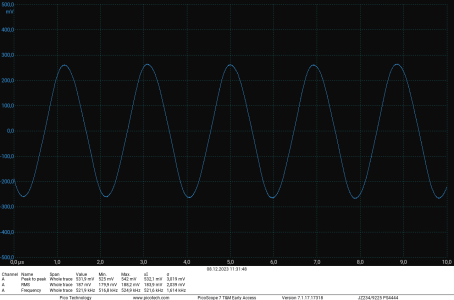
This signal affects the wave shape of my test tone
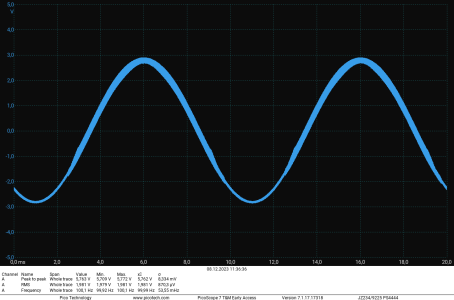
I've been told that it's related to the PSU and it will be eliminated in the next HW iteration.
Sub out signal is a sum of both channels content and can reach 1.98 Vrms in stereo mode for 0 dBFS sine.
The HF switching component can be eliminated by my LPF for further testing purposes
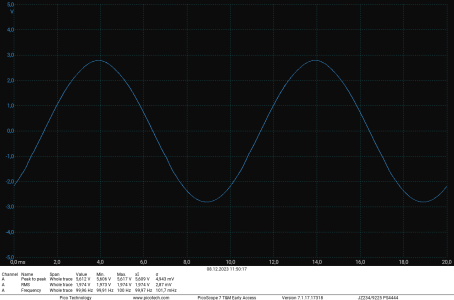
but I didn't see any impact of it on my measurements here, so I'll continue with a combo Cosmos ADC / Scaler. As before both channels are driven.
The sub out performance resembles what I saw during previous tests, below for 0 dBFS input signal:
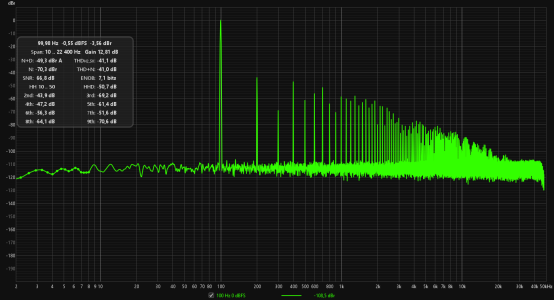
THD, THD+N vs power, this time with LPF due to the gain applied by autoranger in the Scaler

ADC - line in
Just quick tests here using Victor's sine oscillator as the generator of the sine 1 kHz wave. In the absence of digital outputs I've decided to use AirPlay cast feature to minimize the amplifier impact.
ADC reaches full digital scale at around 2.12 Vrms. The noise floor elevates before it happens, at around 1.9 Vrms, which results in further decreasing SNR ratio gradually
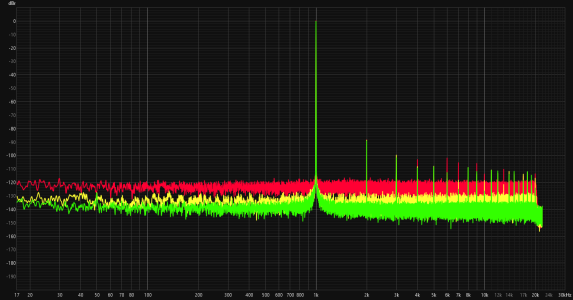
ADC performance seems to be similar to the one in the Pro Plus. It's not a surprise as chip used is the same AFAIK.
Stay tuned. Or maybe that's all, folks
The Amp seems to be a class D BTL H-bridge amp with a single power rail (find someone smarter than me for an explanation), and with an advanced temperature monitoring through some sensors to deliver "optimal performance and safety" which results in the output power optimizations. It has some consequences for measurements.
First of all, the output signal is modulated by high frequency switching signal, 454.5 kHz in this case:

As it shouldn't bother typical speakers, it affects any measurement instruments. Especially noise level increases when BW of the ADC is wide enough.
I will start my measurements with a bare ADC and then I will compare results with the ones when a low pass filter is used to attenuate the switching signal (I hope I will succeed with the build of an LPF).
Second thing is a DC bias on speaker outputs in relation to the amp ground. It's 20V DC which means that the amp is powered internally from 40V DC. That also means that I could burn my ADC AC coupling capacitors as the DC voltage level is too high, when common ground between the amp and ADC is established. I will start my tests with my ADC floating to protect it from the DC bias. I will verify later if using an external AC coupling capacitors brings more reliable measurement results.
And a third thing, those output power optimizations make measurements slightly challenging in case of high output powers as the output voltage may vary and even fluctuate. I've been told that a FW update is incoming with some power related improvements. So far I had to focus on 1W output power results.
Few other facts:
- the Amp can consume as much as 323W AC power for full scale sine signal in stereo at the highest volume and with 4 ohm load. In case of 8 ohm it's reduced to 163W.
- typical consumption is between 11W and 14W when nothing is played, it goes down to 6W for an "idle" mode and can drop to below 1W under some circumstances, in such case the Amp looses its WiFi connection and cannot be awaken with the remote
- max output power is 124W per channel for both channels loaded and 4 ohm load, and 63W for 8 ohm
- USB output can deliver up to 660mA at stable 4.72V voltage
- amplifier gain is around 27 dB
Just one graph for today - some class D amplifiers are known to have a frequency response influenced by load impedance. The same behavior can be seen with the Amp, plot below was made for 1W output power and a sweep with 48 kHz signal:

In real life scenarios it can sound "bright" or "dull", but it will depend on the speaker and its impedance for increasing frequencies.
Just one preliminary result I got for 5W/4ohm sine 1k signal, so quite comparable to measurements usually seen on ASR website:

Unfortunately both noise related measurements - THD+N and SNR - are lower than expected, even with very limited BW. It can indicate that I will need an LPF for better results.
THD: 95.8 dB
THD+N: 89.3 dB
SNR: 90.4 dB
Above is for single channel only.
A word about some concerns I have so far.
My unit is humming, buzzing, or hissing, no idea which word fits the best but the amp produces some noise from itself. It's more quiet with mediocre volume levels but gets louder for high power outputs. And unfortunately also when in idle. I can imagine it won't bother in daily use, but when it sits on the desk it's simply annoying. Fortunately I've been told that the noise is from the power transformer and it won't happen to production units.
Another thing is that the device outputs high frequency component on the sub out. It's at 520 kHz and -15 dBV level which gives the overall Vpp of 680 mV even when no content is played. It's beyond my expertise level to say if it's safe or not for the connected subwoofer but as it affects the performance of my ADC I can imagine it can have some impact on active subwoofers if HF signal is not filtered out. I've been told that the root cause has been identified and it's the power supply.
There are no DAC selectable filters (yet?), the default one seems to be fast, linear phase one, with responses as below


Undithered -90.31dBFS 16 bit sine signal doesn't look very good, but remains undithered

Measurements - optical in to speakers out
EDIT: since I now have LPF, all content has been revised and corrected where necessary
All measurements here are taken with Cosmos ADC and REW. My dummy load is purely resistive, 4 or 8 ohms. Both channels are always driven. Low pass filter against class D switching frequency was used. Amp's volume is set to 100%.
Using the LPF does not bring a significant improvement. Although its filtering capability is impressive


it does not translate into measurement results. The biggest observed differences were related to the noise level for higher sample rates

Linearity is quite good, with 0.5 dB deviation at 110 - 111 dBFS source level (111 - 112 with LPF)

SINAD measured for 5W/4ohm 48 kHz sine signal was 88.7 - 89.1 dB. SNR 90.6 dB. SNR jumps to 103 dB for full power signal.

Dynamic range calculated with -60 dBFS sine signal reaches 105 dB, while noise stays at 124 uV.

IMD distortions measured using SMPTE signal keep low level for 1W signal, but rise significantly at 5W (well, in fact I shouldn't call it IMD, these ones are just harmonics of 60 Hz tone)

It affects badly multitone results which are simply terrible for higher output levels, below 1W vs 5W again

I've enabled a subwoofer output to verify if it influences results, but no, still horrible

The frequency response shows a dependency to the load, as mentioned already. As a result the response within +/- 0.5 dB deviation covers an audible range fully for 4 ohm, but reaches 14 kHz only for 8 ohm load.

THD vs power shows similar performance for 1kHz sine signal and 4 vs 8 ohm load

THD+N vs power plots for different frequencies show increased distortions at lower frequencies
4 ohm

8 ohm

Best results at high powers are achieved around 5 kHz, it's also visible on THD vs frequency plot, below for 8 ohm, 5W

Harmonic distortions are dominated by uneven ones, below for 1 kHz sine at 4 ohm

SMPTE vs power and multitone vs power both show similar total distortion curves, as affected mainly by low frequency issues, 4 ohm
SMPTE

Multitone

While right channel shows slightly better performance for low frequencies

it's opposite for high frequencies

My conclusion for this part is that the performance for low frequencies is, again (Pro Plus V1?), disappointing. While the Amp measurements are similar to the ones seen for other 3255 implementations, low frequencies are broken. It's unclear to me if it's an issue of my particular unit or it's a design flaw, as other measurements are not yet available publicly.
Output impedance is as below (using 4 ohm load for measurements)

Measurements - optical in to sub out
For this purpose I use 200 Hz crossover frequency and 100 Hz test sine signal.
Just like for speakers output, the subwoofer output is also affected by the HF switching signal at around 521 kHz

This signal affects the wave shape of my test tone

I've been told that it's related to the PSU and it will be eliminated in the next HW iteration.
Sub out signal is a sum of both channels content and can reach 1.98 Vrms in stereo mode for 0 dBFS sine.
The HF switching component can be eliminated by my LPF for further testing purposes

but I didn't see any impact of it on my measurements here, so I'll continue with a combo Cosmos ADC / Scaler. As before both channels are driven.
The sub out performance resembles what I saw during previous tests, below for 0 dBFS input signal:

THD, THD+N vs power, this time with LPF due to the gain applied by autoranger in the Scaler

ADC - line in
Just quick tests here using Victor's sine oscillator as the generator of the sine 1 kHz wave. In the absence of digital outputs I've decided to use AirPlay cast feature to minimize the amplifier impact.
ADC reaches full digital scale at around 2.12 Vrms. The noise floor elevates before it happens, at around 1.9 Vrms, which results in further decreasing SNR ratio gradually

ADC performance seems to be similar to the one in the Pro Plus. It's not a surprise as chip used is the same AFAIK.
Stay tuned. Or maybe that's all, folks
Last edited:

